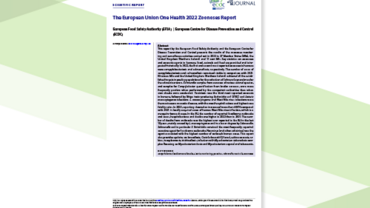The European Union Summary Report on Trends and Sources of Zoonoses, Zoonotic Agents and Food-borne Outbreaks in 2012
This report shows information submitted by 27 European Union Member States on the occurrence of zoonoses and food-borne outbreaks in 2012, analysed by the European Centre for Disease Prevention and Control and the European Food Safety Authority.
This file replaces the earlier version published on 19 February 2014
Note (13 October 2015): The joint EFSA/ECDC reports were reviewed due to inconsistencies in datasets from some EU Member States. These inconsistencies came to EFSA’s attention 2015. In the 2012 report, the revised data related to Salmonella. In the 2013 report, experts reviewed data on Salmonella, Verocytotoxin-producing Escherichia coli (VTEC) and West Nile virus.
None of these changes affect the human data reported for these years.
The revised documents were published in March 2016
Executive Summary
The European Centre for Disease Prevention and Control and the European Food Safety Authority launched their annual report on zoonoses and food-borne outbreaks.
Although the report shows a slight decrease in human cases of campylobacteriosis in 2012 compared with 2011, with 214 268 confirmed cases, it remains the most commonly reported zoonotic disease and it is premature to suggest that this is the beginning of a downward trend.
The number of salmonellosis cases in humans has continued to fall, decreasing by 4.7% from 2011 to 2012, marking a decrease for the seventh consecutive year. However, Johan Giesecke, Chief Scientist at ECDC, said “The decreasing trend of salmonellosis is very encouraging. However our evidence shows that any Salmonella serovar can cause human illness which requires continued surveillance and vigilance.”
On the other hand, the trend in reported human cases of listeriosis has been increasing over the past five years, with a 10.5% rise between 2011 and 2012 with 1 642 confirmed cases reported.
The report provides data on zoonotic diseases and on food-borne outbreaks in the EU for 2012, and supports the European Commission and EU Member States in monitoring and reducing risks related to zoonotic diseases.






